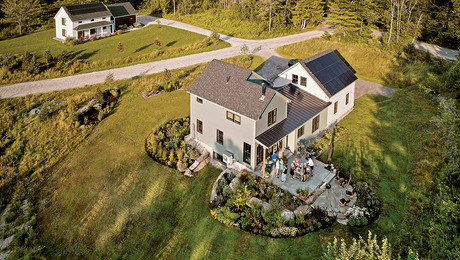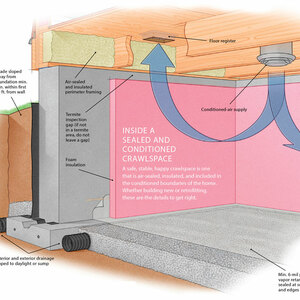Hello. I’m considering WarmBoard for a future radiant installation. That’s a lot of metal! Should I expect any interference/shielding problems with any of my wireless communication devices between floors? I’ll be using cordless phones, PCS phones, and possibly a wireless computer network Has anybody had any RF problems with other radiant panels? Thanks, Bernie
Discussion Forum
Discussion Forum
Up Next
Video Shorts
Featured Story

By considering things like energy-efficient mechanicals, window orientation, and renewable energy sources, homes can be evaluated to meet the energy codes. Here's what the IRC has to say.
Featured Video
Video: Build a Fireplace, Brick by BrickHighlights
"I have learned so much thanks to the searchable articles on the FHB website. I can confidently say that I expect to be a life-long subscriber." - M.K.

















Replies
No worries, Bernie. Just have them install a defrizzilator. When you wake up each morning, touch your bare toe to the small metal grounding plate that's connected to the defrizzilator. That eliminates any static buildup in the system and will ensure no problems with your electronics.
O.K. Mongo...
I did a search on WarmBoard before I posted this question. You seem to be one of the WarmBoard experts. So if anybody can give me a straight answer on this I hope it would be you! I know if I ask the WarmBoard people about this it will be "no problem".
So, do you know anyone with radiant panels in their homes having these concerns?
Dang! Foiled again!
I threw you a curve ball with the "defrizzilator".<g>
The Al layer in the warmbooard won't cause any problems at all with your electronics.
The only problems I've seen in houses regardng audio/video is interference caused by running Cat-5 type stuff too close to...or even in the same holes with...the house's ac wiring. Keep them separate, and when you can't, cross them at 90-degree angles.
THAT'S GOOD NEWS!
Hey, a little fun and a lot of helpful information... THAT'S what makes this a great forum.
Thanks for the "pro" advice.
BTW, you mentioned running CAT5. That brings up another question that I have. Do you know a brand name of a low voltage (bundled) cable where it has various lines for cable TV, phone, CAT5, alarm, etc. all sheathed together? I saw this on one of the "Home Shows". Sounds like a good way to outfit a home for the 21st century. Thanks.
Here's a bundledCat5E, RG6, and fiber optic cable. They have options that have Cat6 instead of Cat5E, and they also have either of the above (Cat5E or Cat6) with RG6 and without the fiber optic. Here's another company, pretty much the same offerings. Good sites, lots of options. Worth sending away to both companies for a catalogue. Regards, Mongo
I'd suggest some careful planning if you are going to use structured cable. While it IS MUCH easier to pull, you need to think about what you are trying to accomplish. It's pretty unlikely that you'll need the fibre optic lines. These are ussually used in large infrastucture architecture, not in the house, except for in AV to AV component interconnection. And even then, the usual choice for AV distribution, even in the digital format is CAT5, CAT5E, or CAT6.
Also, if you have a satelite system for television service, it's a good idea to run phone lines to the location of the DSS receivers, which may, or may not be the same as the TV location. (If you are hiding the components in a location across the room, do some homework to decide on what kind of wire you want to run from the output of the tuning device to the input of the TV. Often, running low level AV wires will result in better quality than running the whole RF signal over an RG-6)
In most cases, though, it's best to "home run" all the CATV/DSS distribution wires (RG6 Quad sheild) to a central "Home" location and do all the multi-switching or splitting there. The phone wires that accompany these runs really don't need to be anything special, but will probably wind up being CAT5 as it's in the bundle, and is pretty cheap.
BUT, running the structured bundle made up of two CAT5s and one RG6 is usually not a great idea, as rarely is the phone located right next to the TV!
So, spend a minute before buying that 4 or 5 wire bundle....you'll save yourself time and money if you don't really need all that stuff! And really, the only way to "Future proof" your house is running conduits. I always suggest a couple conduits from the "home" location (basement if possible) to the attic, but be careful! Somebody always grabs them before the house is even completed!
Good luck!!!
Jake
Very sound advice. I try to talk HOs in new construction into allowing, paying for, me to run a few runs of 1-1/4" PVC to likely locations. Serious AV people can sometime benefit from a 2" run or two to handle the number of wires they use. Even if it is a single storey home with both a crawl space and attic a few pieces can make things easy to pull in or update later.
Some go for it. Some don't. I usually hear from those that do that they are glad they did. While I'm at it I try to throw in a few more receptacles in locations destine to hold the AV or computer gear. Maybe even a dedicated run or two.
Mongo, thanks again. Those are good sources. Looks like I've got some shopping to do.
Later, Bernie
Bernie,
Another source of structured cable is Home Depot, they carry the 2 RG6, 2CAT5E, and 2 Optical for $424 a 500' roll in the Seattle area.
Jason
Thanks. Pretty good price and no shipping. I've got an HD right across the street. I'll check it out. --B